moogerfooger
USER'S MANUAL
RING MODULATOR
WELCOME
Welcome to the world of the Moogerfooger® Effects Plug-ins, a re-invention of Bob Moog’s classic analog effects modules using DSP artistry to bring the legendary performance and musicality of the original hardware effects to your digital music production environment.
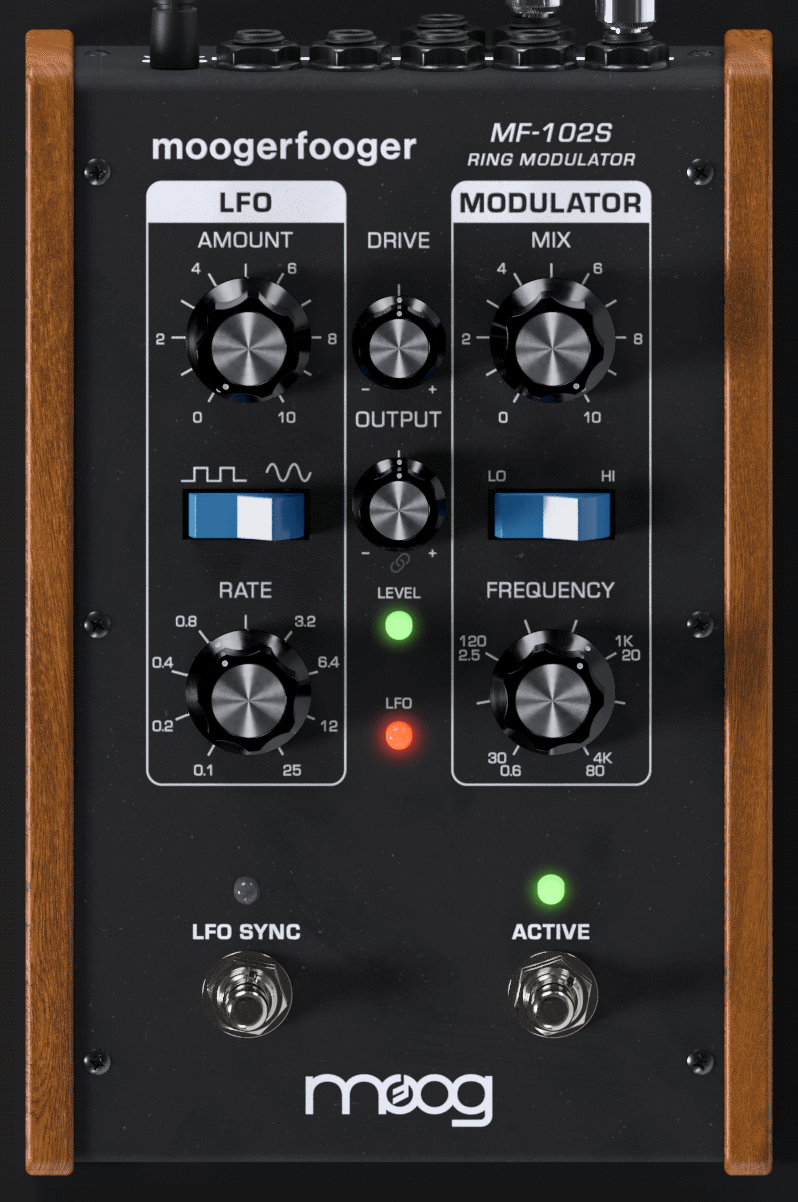
The MF-102 Ring Modulator, introduced in 1998, was a direct descendant of the original Moog modular synthesizers. It contained three complete modular functions: a Ring Modulator, a voltage-controlled Carrier Oscillator, and a voltage-controlled dual-waveform Low Frequency Oscillator (LFO). All the performance parameters could be voltage-controlled, which allowed the player to use expression pedals or any other source of control voltage to tweak and “play” the effect settings dynamically, making the MF-102 closer to a performance instrument than a simple effect.
The MF-102S retains this same design, with all parameters able to be played, tweaked, automated and modulated to create lively and truly musical performances. The MF-102S captures not only the spaced-out, retro-futuristic sound of the original, but also the organic way in which the parameters interact to create a musical playing experience. Adding a Moogerfooger effect to your sound invites exploration and experimentation to bring your unique musical expressions to life.
GETTING STARTED
In your Digital Audio Workstation (DAW) software, place the MF-102S plug-in on an instrument or audio track.
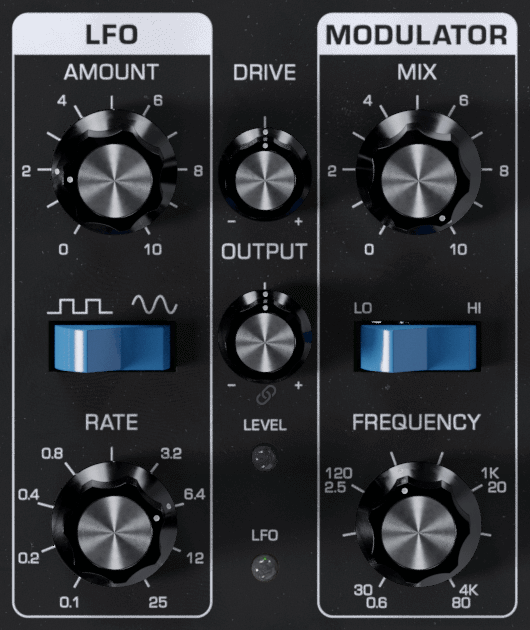
Set the MF-102S panel controls as follows:
AMOUNT – 2
RATE – 6.4
MIX – 10
FREQUENCY – 250
Left Switch – sine waveform
Right Switch – HI
With audio playing on that track so you can hear the effect, listen to how the MF-102S affects the quality of the sound. You will hear a distinct vibrato. Note that the AMOUNT knob affects the strength of the vibrato and the RATE knob affects the vibrato's speed. Try turning up the DRIVE knob to add warm, analog-style saturation to your sound. If adding DRIVE makes the audio too loud, turn down the OUTPUT knob to dial it back to the desired level. A small LINK button below the OUTPUT knob will link the DRIVE and OUTPUT controls, to maintain a constant audio level automatically when either DRIVE or OUTPUT is adjusted.
In the next section we'll explain exactly how a ring modulator works, what the carrier oscillator and LFO do, and how the controls work. For now, get a feel for the controls by experimenting with different settings.
HOW A RING MODULATOR WORKS
Let's start with some definitions. Please read this section carefully, as it will help you to understand the basic ideas underlying ring modulation. Sound is a vibration of the air. The speed of vibration is called the frequency. It is measured in Hertz (Hz). One Hz is one vibration per second. We hear vibrations from around 20 Hz to 20,000 Hz.

Musical sounds generally have many frequency components. They're called harmonics, or overtones, or partials. They are what give the sound its characteristic tone color, or timbre. We can represent a musical sound either as a waveform or as a spectrum. The waveform is a time graph of the actual shape of the vibration, while the spectrum shows how strong each of the sound's harmonics is.
The waveform of a single harmonic is called a sine wave. The spectrum of a sine wave is just a single line. The first figure below shows the waveform and spectrum of a 500 Hz sine wave, while the next figure shows the waveform and spectrum of a 100 Hz sine wave. If you listen to a 500 Hz sine wave, you hear a pitch nearly an octave above middle C, with a mellow, muted quality, like a flute or a whistle. A 100 Hz sine wave also sounds mellow and muted, but its pitch is more than an octave below middle C.

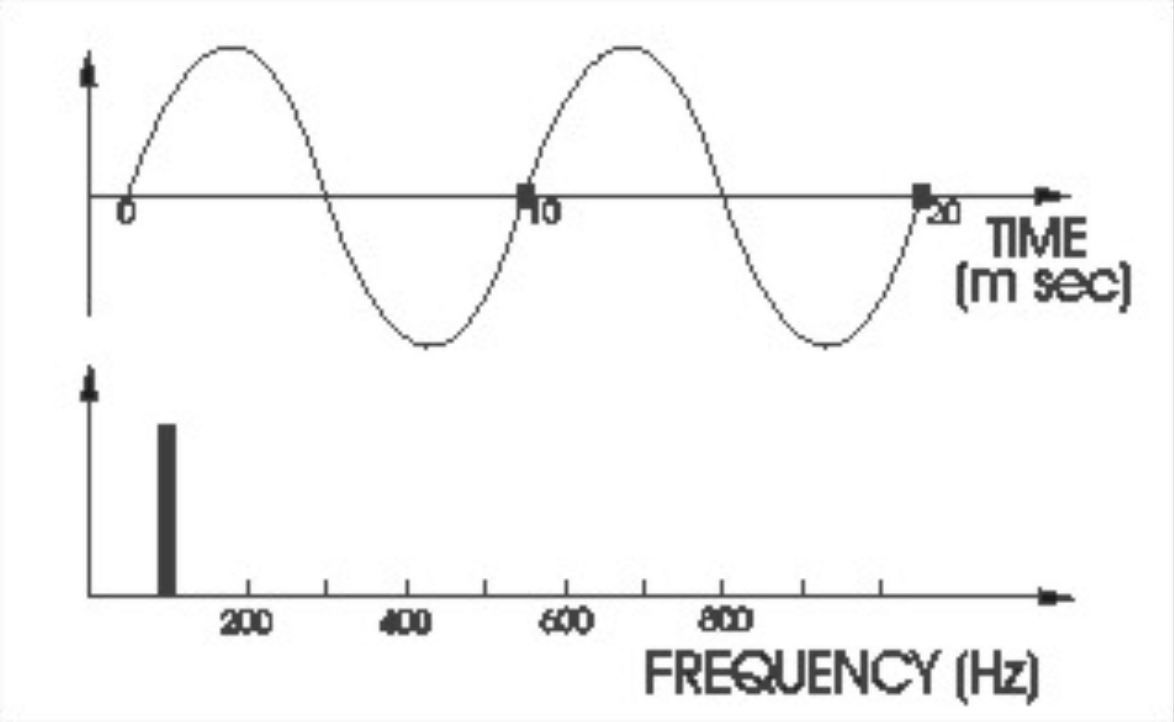
Now we're ready to talk about what a ring modulator is. In electronics, modulation is any process in which one waveform is changed in response to the contour of another waveform. For instance, amplitude modulation is the shaping of the amplitude (strength) of one waveform by the contour of another waveform. The "AM" in "AM Radio" stands for amplitude modulation. An AM Radio signal coming from a transmitting tower consists of a very high frequency, called the carrier, which has been amplitude modulated by an audio signal, called the program.
Any analog signal can amplitude-modulate any other analog signal. A common example of amplitude modulation in electronic music is tremolo. Tremolo is the amplitude modulation of an instrument signal by a sine wave of a few Hz or so.
Ring modulation is a special type of amplitude modulation. A ring modulator circuit has two inputs and one output. If a sine wave of one frequency is applied to the first input and a sine wave of another frequency is applied to the second input, neither of these input frequencies appears at the output. Instead, two new frequencies appear. One is equal to the sum of the two input frequencies, and the other is equal to the difference between the two frequencies.
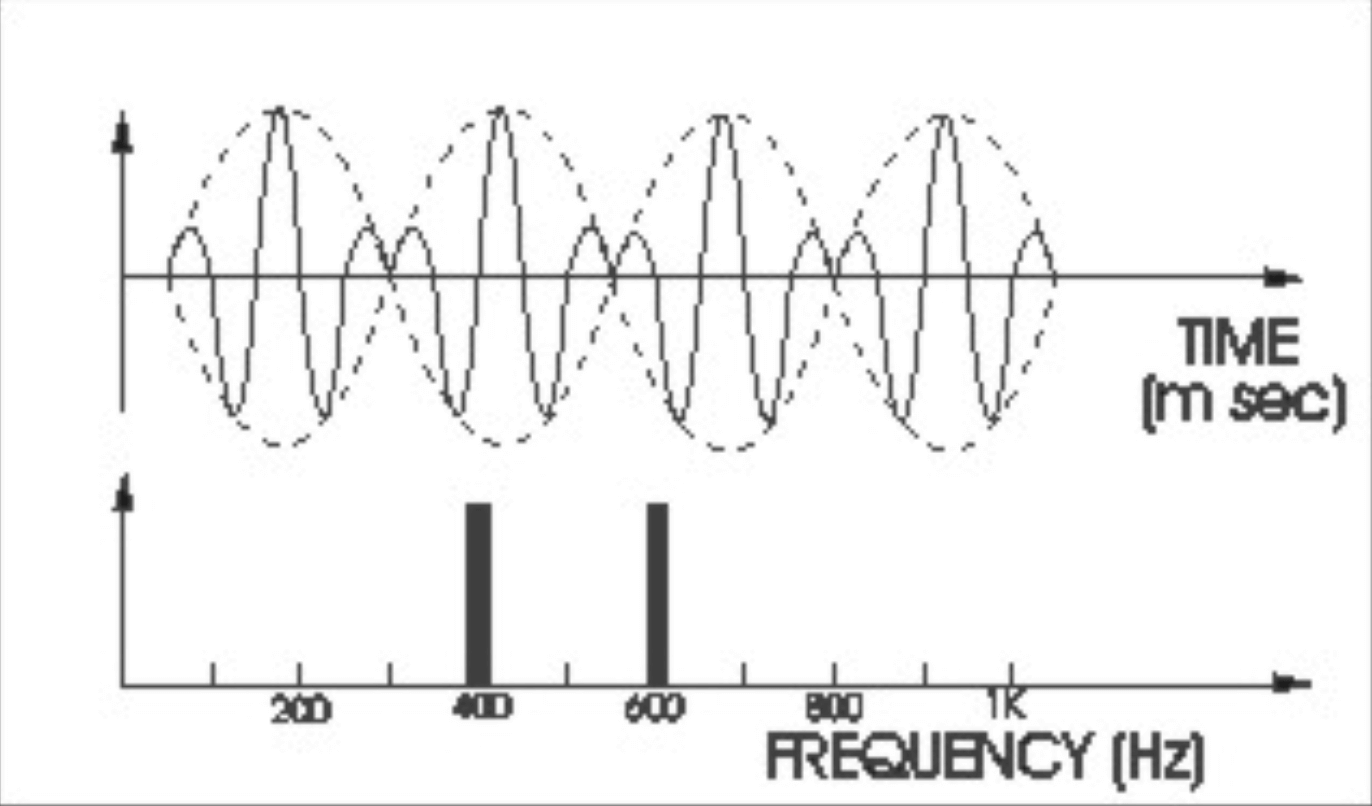
For instance, if the sine wave at the first input is 500 Hz and the sine wave at the second input is 100 Hz, then the output contains a 600 Hz sine wave and a 400 Hz sine wave. The resultant output waveform is complex. It looks like a 500 Hz sine wave that is amplitude modulated around its center axis by a 100 Hz sine wave. When you listen to it, you hear two pitches: 400 Hz and 600 Hz. You do not hear either the 500 Hz or the 100 Hz input signals.
What if the first input signal has many harmonics? In that case, the ring modulator output contains the sum and difference frequencies between all the harmonics of the first input, and the single frequency of the second input. The illustrations below show what happens when the first input is a 500 Hz square wave and the second input is a 100 Hz sine wave. The first image below shows the waveform and spectrum of a 500 Hz square wave. This waveform has only odd harmonics. The first harmonic (usually called the fundamental) is 500 Hz, the third harmonic is 1,500 Hz, the fifth harmonic is 2,500 Hz, and so on. This set of harmonics produces a tone that sounds bright and hollow. When this waveform is ring-modulated by a 100 Hz sine wave, the resultant spectrum contains components whose frequencies are 400 Hz, 600 Hz, 1,400 Hz, 1,600 Hz, 2,400 Hz, 2,600 Hz, and so on. The second graph shows the waveform and spectrum of the ring modulation of a 500 Hz square wave by a 100 Hz sine wave.
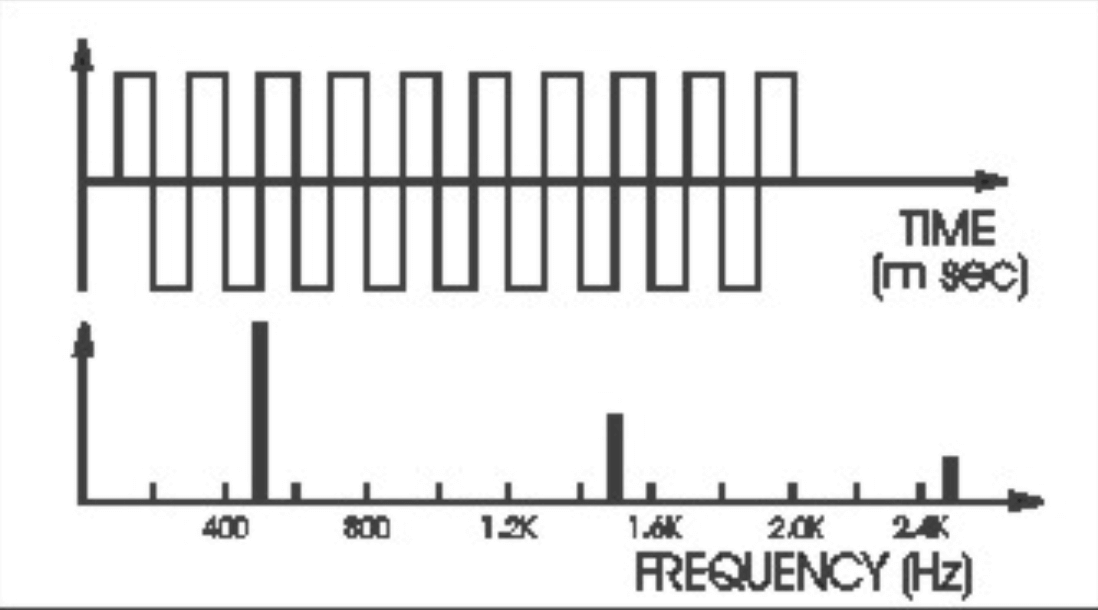
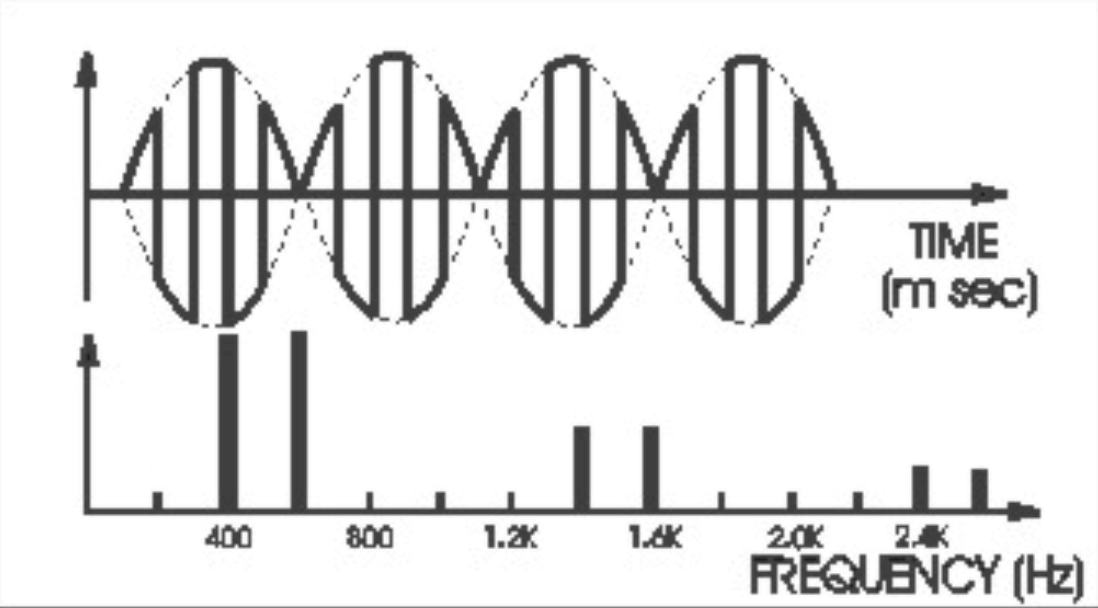
WHAT IS THE CARRIER OSCILLATOR?
The MF-102S contains a wide-range, virtual-analog oscillator that produces a sinelike waveform. We call this the carrier oscillator because, like the carrier of an AM signal, it’s always there, ready to be modulated by any sound that you play. The carrier oscillator’s frequency is determined by the setting of the FREQUENCY knob and the LO-HI switch above it. The carrier oscillator frequency range extends from 0.6 Hz to 80 Hz on the LO setting of the switch, and from 30 Hz to 4 kHz on the HI setting of the switch.

To hear the effect of changing the carrier oscillator frequency, first set up the MF-102S as follows:
AMOUNT – 0
RATE – (doesn’t matter)
MIX – 10
FREQUENCY – 30/0.6
Left Switch – (doesn’t matter)
Right Switch – LO
Play a few simple, sustained notes through the effect. You will hear your instrument sound with a slow, smooth tremolo. Your instrument will get soft and loud twice for each cycle of the carrier oscillator.
Now turn the FREQUENCY knob up one mark, and play the notes again. You will hear the tremolo get faster. Technically speaking, even at this low carrier frequency, your music signal is split into two sets of harmonics. However, the frequency difference between the two sets is so small that you really don’t hear them as different pitches.
Continue to turn up the FREQUENCY control, one mark at a time, playing a few simple, sustained notes at each mark. You will hear the tremolo get faster and faster. When the carrier frequency is above 20 Hz or so, the MF-102 output will no longer sound like a tremolo. Instead, your sound will begin to sound “rough” and “detuned” because the two sets of harmonics are far enough apart so you begin to hear them as two distinct sounds.
When the FREQUENCY control is as far clockwise as it will go, turn it all the way back and set the switch on HI. Continue to play simple, sustained notes while turning the FREQUENCY control clockwise. Listen carefully. You will hear some pitches going up (the sum frequencies) and some going down (the difference frequencies).
What happens when a difference frequency gets down to zero and you continue to turn the carrier frequency up? Technically speaking, the difference frequency then becomes negative. But as far as our ears are concerned, a negative frequency sounds just about the same as a positive frequency! So, as you continue to turn the carrier frequency up while you’re playing, you’ll hear the difference frequencies first go down, then start to come up, one by one. When the carrier frequency is up around 4 kHz, nearly all of the output sound will be very high pitched, even if you play low-pitched notes on your instrument.
WHAT IS THE LFO, AND WHAT DOES IT DO?
LFO stands for Low Frequency Oscillator. LFO’s are generally used to create slow modulations such as vibrato and tremolo. The LFO in your MF-102 is a wide-range, dual-waveform, voltage-controlled oscillator which frequency-modulates the carrier oscillator. This enables you to move the sum and difference frequencies toward and away from each other at speeds from one cycle every ten seconds, to 25 times a second, with either a square wave or a sine-like wave contour.

To hear the effect of changing the carrier oscillator frequency, first set up the MF-102S as follows:
AMOUNT – 4
RATE – 0.1
MIX – 10
FREQUENCY – 120/2.5
Left Switch – sine waveform
Right Switch – HI
With the MF-102S on an instrument track, play a few simple, sustained notes through the effect. You will hear the sum and difference frequencies slowly drifting apart, and then together, once every ten seconds or so. This is the result of the 0.1 Hz LFO triangular wave modulating the carrier oscillator frequency. The setting of the AMOUNT knob determines how much the carrier oscillator is being frequency-modulated, while the setting of the RATE knob varies the LFO frequency. Experiment with these two controls to hear the effect of the LFO over its entire range. Then set the left switch to square waveform to hear the difference between the two LFO waveforms.
TOURING THE PANEL FEATURES
The LFO Section

Let's look at the LFO section first. The two control knobs are AMOUNT and RATE. In addition, there is a “square-sine” waveform switch. The LFO light shows the speed at which the LFO is oscillating.
The AMOUNT knob determines the amount of LFO waveform that frequency-modulates the carrier oscillator. When the knob is counterclockwise, there is no frequency modulation by the LFO. When the knob is fully clockwise, the carrier oscillator is frequency-modulated over a range of three octaves.
The RATE determines how fast the LFO oscillates. The knob spans the frequency range of 0.1 Hz (one cycle every ten seconds) to 25 Hz.
The “square-sine” waveform switch selects either the square waveform or the sine-like waveform that the LFO produces. The square wave produces trill effects, whereas the sine waveform produces vibrato and siren effects. The LFO light is illuminated by the LFO waveform. You can use it to get a visual indication of the LFO’s speed.
The Modulator Section

The MIX knob, the FREQUENCY knob, and the LO-HI switch are all part of the Modulator section.
The MIX knob crossfades from the direct (unmodulated) signal to the signal from the ring modulator output. You hear only the direct signal when the knob is counterclockwise, and only the ring-modulated signal when the knob is clockwise. You crossfade smoothly from one signal to the other as you turn the knob.
The FREQUENCY knob and the LO-HI switch determine the frequency of the carrier oscillator. The FREQUENCY knob has two calibration ranges: 0.6 Hz to 80 Hz, and 30 Hz to 4 kHz. The LO-HI switch setting determines which range is on.
Audio Level Control

The DRIVE control and the LEVEL light are part of the audio input level circuitry.
The DRIVE control adjusts the input gain. With this control you can set the right input gain for virtually any instrument or line-level signal source. Turn this control counterclockwise for strong input signals, and clockwise for weaker sound sources.
The LEVEL light tells how strong the input signal is after being adjusted by the DRIVE control. As the signal level increases, the light goes from off, to green, to yellow, and finally to red. Very weak signals do not light up this light at all. When the light is green, the signal is below the level that results in audible distortion. When the light is yellow, some low order distortion may be audible, giving the sound a subtle warm analog quality. When the signal is strong enough to drive the light into the red, the distortion at the output becomes stronger and more distinctly audible. Watch this light when you set the DRIVE control for the desired effect.
The OUTPUT control provides positive and negative gain for the final output of the effect, after the drive and modulation. This allows you to dial in the amount of drive and saturation you want for your sound while keeping the signal level in a good range for further processing.
The LINK button just below the OUTPUT control links the DRIVE and OUTPUT controls; as you turn one control up, the other is automatically turned down in order to maintain unity gain through the effect.
Switches
LFO SYNC – Enables the LFO rate to sync to the project tempo. When the LFO SYNC light is on, the LFO RATE knob selects beat-synchronized divisions of the master tempo for the LFO rate. When the LFO SYNC light is off, the LFO is free-running, and the RATE knob sets the LFO speed in Hz (cycles per second).
ACTIVE – Controls whether audio input is sent into the effect. When the ACTIVE light is green, the effect is active. When the ACTIVE light is off, the audio input is passed directly to the output and is not sent into the effect.
NOTE: When the effect is not active, the CV outputs still continue working, to fully disable the pedal, use the bypass feature that your DAW provides
ADVANCED PLUG-IN FEATURES
Modulation Inputs
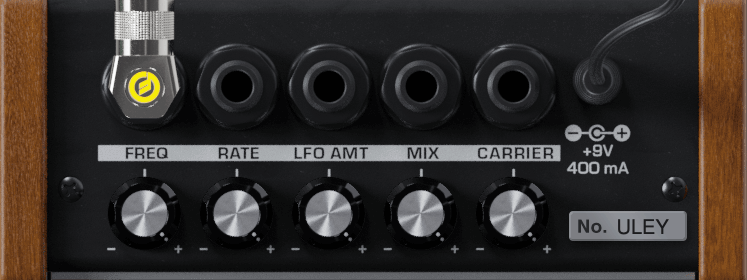
The original Moogerfooger effects provided input jacks for voltage control of the parameters, using expression pedals or other control voltage (CV) sources connected in classic modular synth style. The MF-102S brings this dynamic connection concept to the world of plug-ins, by providing virtual “CV Ins” which you can connect between any instances of any Moogerfooger Effects Plug-ins within your project.
NOTE: CV connections are stored in your DAW project, but not in the presets of each Moogerfooger Effects Plug-ins.
The MF-102S offers CV Inputs to modulate Carrier Frequency [FREQ], LFO Rate [RATE], the LFO Amount [LFO AMT], and Mix [MIX]. You can also override the internal carrier oscillator with a different carrier signal with the CARRIER input. Click on one of these CV IN jacks to see the connection options which are available.
TIP: As with the original Moogerfoogers, you can connect a pedal to itself to create more interesting sonic interactions than what's available on the front panel!
A list of all Moogerfooger Effects Plug-in instances which are active will appear in the drop-down menu, as well as the modulation sources they provide. Each plug-in instance is identified on this menu by a unique, randomly generated four-letter code. The same code is displayed on the “back panel” UI of the plug-in itself, in the lower right corner of the CV Input jack panel. This allows you to distinguish between multiple instances of the same plug-in. Choose any modulation source to make a connection.
The strength of the selected modulation is controlled by a bipolar knob below each CV IN jack, with zero (no modulation) in the center, increasing positive modulation if you turn the knob to the right, and increasing negative modulation if you turn the knob to the left.
TIP: Double clicking on the attenuator knob will reset it to zero.
Above the list of Moogerfooger Effects Plug-in instances are a handful of additional options and input sources:
- None - will remove any connections currently made to this CV input.
- Bipolar - will be available as an option if the chosen modulation source (an LFO for example) can be bipolar - centering the modulation around the current knob value.
- DC - provides a DC offset that you can scale with the associated attenuator. Since the CV attenuator itself can be automated or MIDI mapped, you can use this like an expression pedal. It will provide the same range of automation/modulation to a parameter regardless of any presets you choose.
- Side Chain - allows you to use an independent audio signal from another track as a modulation input. You can select either the Left or Right Input from stereo signals. Your host software will see the Side Chain Input as an additional input to the plug-in, which you can connect to the audio source of your choice.
NOTE: The CV side chain is designed to take DC-coupled analog or digital CV signals - regular audio signals might yield surprising results.
Visualizing Modulation
Making a CV connection will insert a virtual 1/4" cable into the top of your Moogerfooger (which can also be seen when you expand to see the back panel by clicking "CV" or the row of jacks across the top of the pedal). The incoming modulation signal will be seen in yellow on the connector. Additionally, the knob corresponding to the parameter being modulated (if present - not all parameters have a corresponding knob) will show a white circle indicating the current value due to modulation.
Settings
CARRIER TYPE
The MF-102S is a true stereo effect, while the original MF-102 was a mono effect with a single signal path and carrier oscillator. The MONO setting emulates the original sound of a single monophonic carrier oscillator, while the STEREO setting provides an independent carrier signal for the left and right channels, allowing the stereo imagery of your source material to provide extra dynamics and detail to the resulting sound. PANNING creates an out-of-phase stereo carrier oscillator, such that the left and right channels will swell and fade in alternating fashion to create a back-and-forth panning effect. REVERSE creates the same panning effect in the opposite direction.
LFO POLARITY
This setting determines whether the LFO is centered around zero, or if zero is the lowest point and the LFO is only positive. BIPOLAR causes the LFO to bend the carrier frequency both higher and lower, relative to the frequency with no LFO applied. UNIPOLAR causes the LFO to bend the carrier frequency only faster, such that the frequency when the LFO is at the lowest point in its cycle is the same as the unmodulated carrier frequency (with no LFO applied).
Additional UI Interactions
Double-click any control to reset it to its default position.
Hold the CTRL key while adjusting any knob for more precise fine-tuning.
PRESETS
In addition to your host software’s plug-in preset management system, the MF-102S provides an easy-to-use, built-in browser for selecting and saving presets.
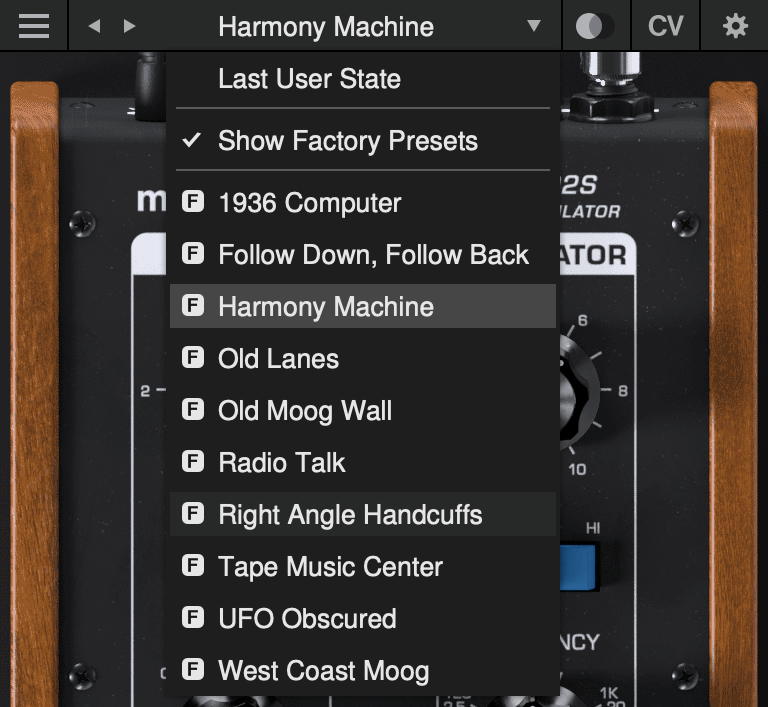
The currently selected preset name is shown at the top of the plug-in UI window. Click the left and right arrows to the left of the preset name to scroll through the preset list. Click the down arrow to the right of the preset name to expand the list and view all presets.
Last User State
The top option on the preset drop-down menu is Last User State. If you load a preset at a time when you had made changes to the plug-in settings which were not saved, your unsaved changes are automatically saved as the Last User State. This allows you to easily compare an existing preset with some new settings which you are still dialing in, or to go back after a preset change without losing your work. Only the most recent unsaved User State is captured in this way. An unsaved User State is indicated by an asterisk (*) to the left of the active preset name.
Show Factory Presets
Some people love the convenience of factory presets; others prefer to use only their own custom settings in their music. You can choose to hide the factory presets and show only your own original presets in this drop-down list by unchecking Show Factory Presets. If Show Factory Presets is checked, then all presets including the factory set will appear in the list. Factory presets are indicated by an F icon to the left of the preset name.
Compare Switch
Directly to the right of the preset drop-down is the Compare switch, which switches between the last loaded state and the last changed state. Load a preset, play around with it, and then click the Compare switch to toggle between the preset loaded and your most recent modifications to it.
Presets Menu
- Init Preset – creates a new INIT preset as a starting point for sound design.
- Save Preset – saves the current state to the currently-active preset. Overwrites the previous state of that preset.
- Save Preset As… – saves the current state as a new preset with a new name.
- Delete Current Preset – deletes the currently-active preset. Factory presets cannot be deleted in this way.
NOTE: You can also drag and drop preset files onto the plug-in UI to import them automatically.
- Export State - allows you to choose any folder in your computer’s file system and save the current plug-in state as a new preset in that location (Save Preset and Save Preset As will automatically place saved presets in the plug-in’s own Presets folder).
- Open Presets Folder - opens the plug-in’s Presets folder on your system’s desktop (Finder or File Explorer).
- Open Manual - opens this manual in your web browser.
- Contact Us For Help - opens the Moog Music customer service website.
SUPPORT
Moogerfooger Effects Plug-ins are designed for macOS 10.13 / Windows 10 systems or newer.
VST3, AudioUnits, and AAX plug-in formats are supported.
Should you experience any issues with your Moogerfooger, please contact [email protected].